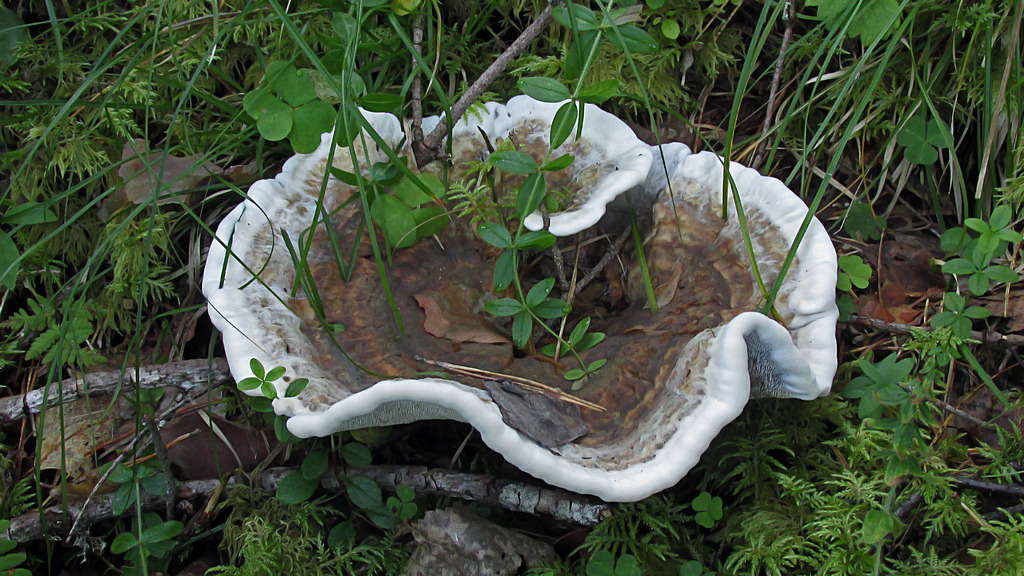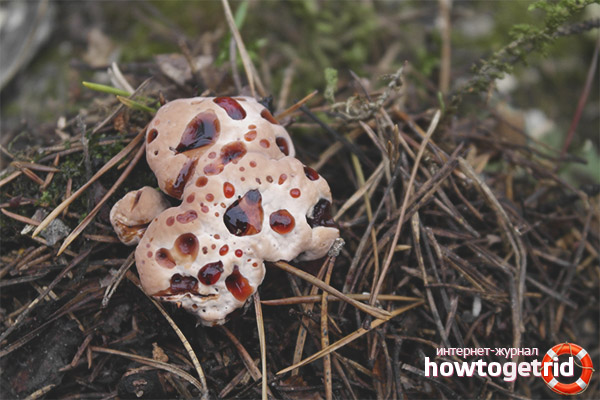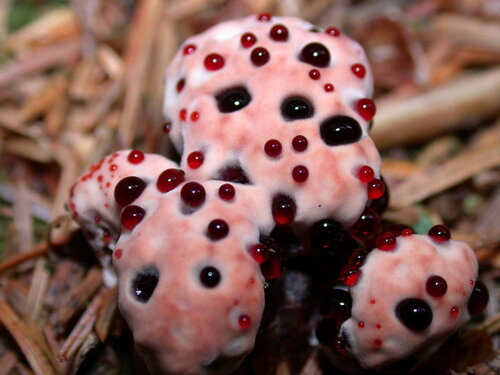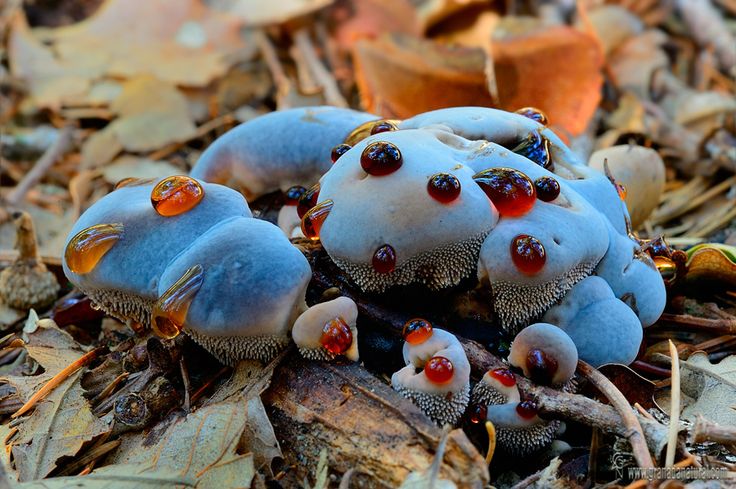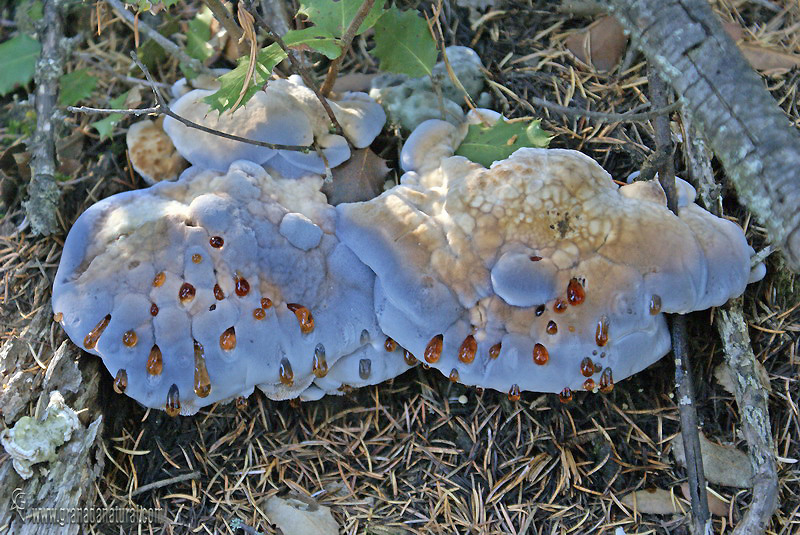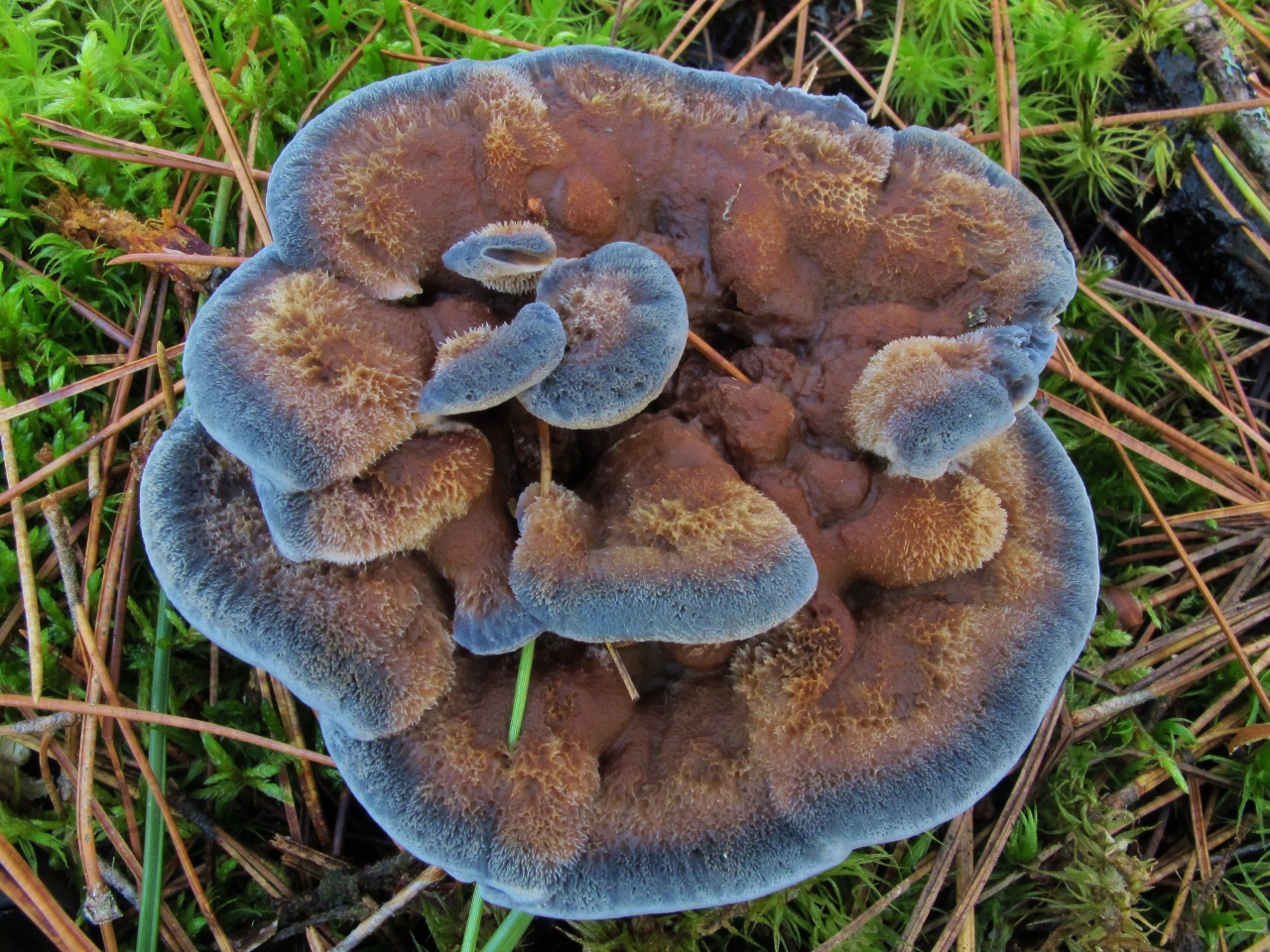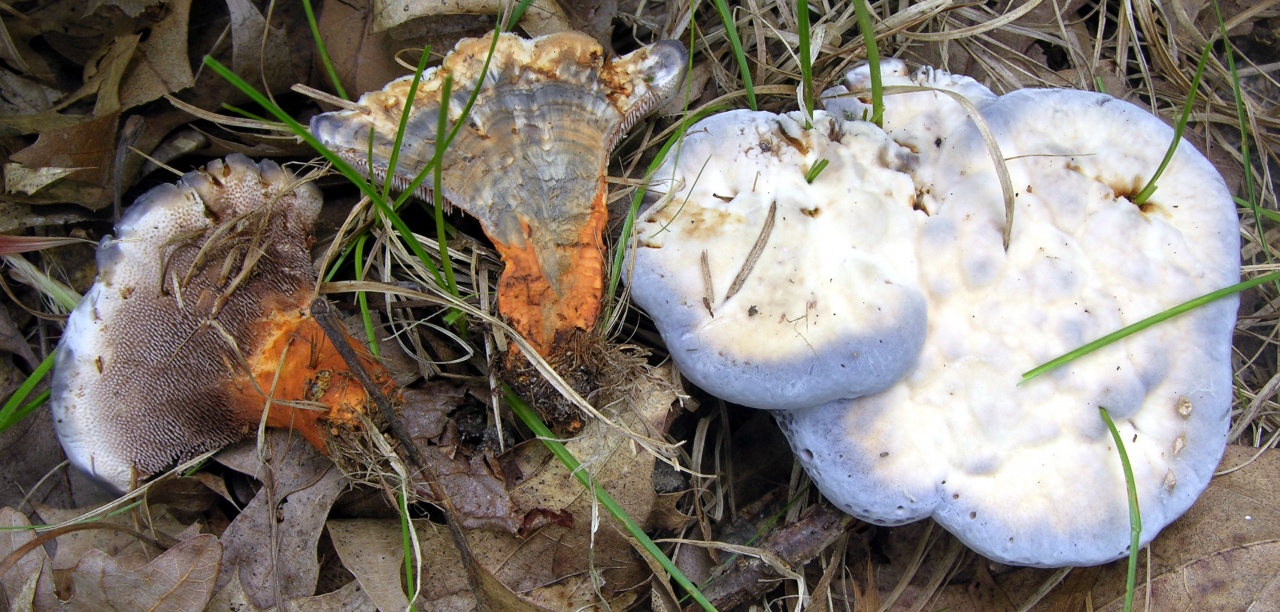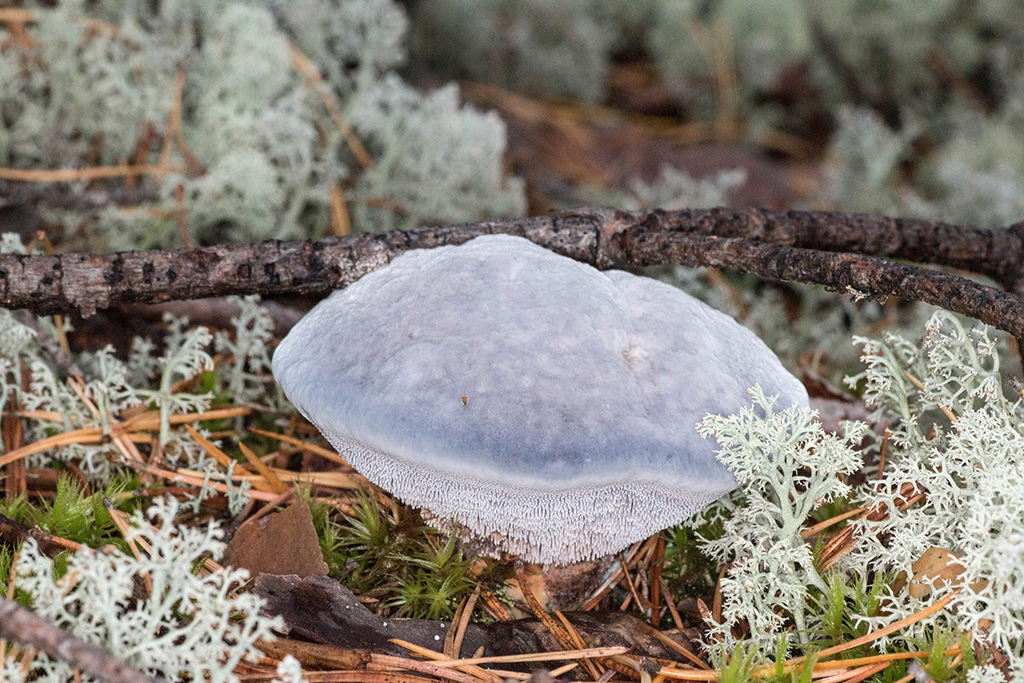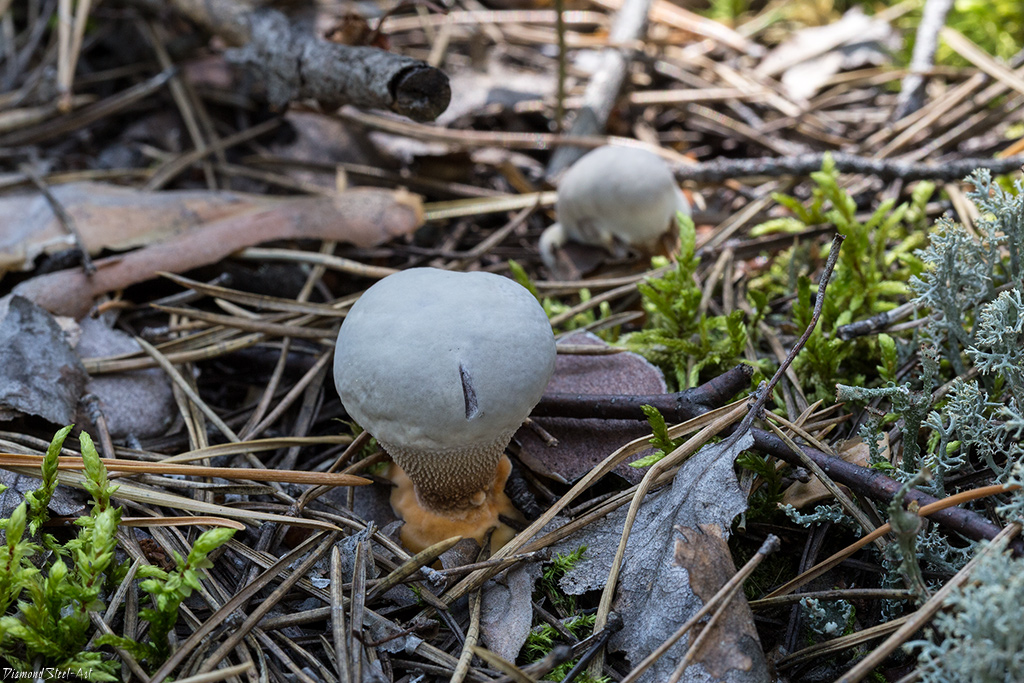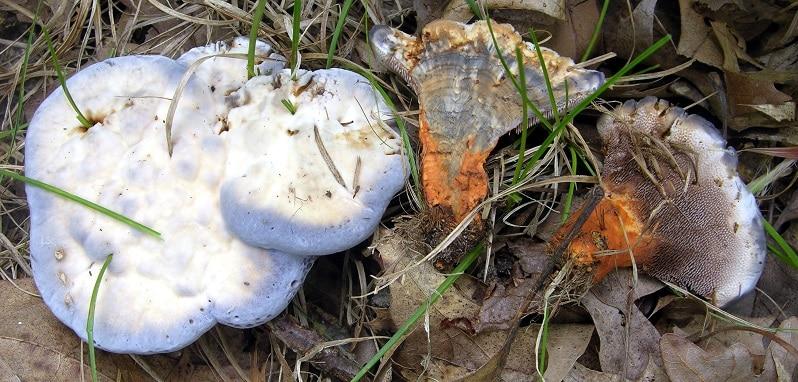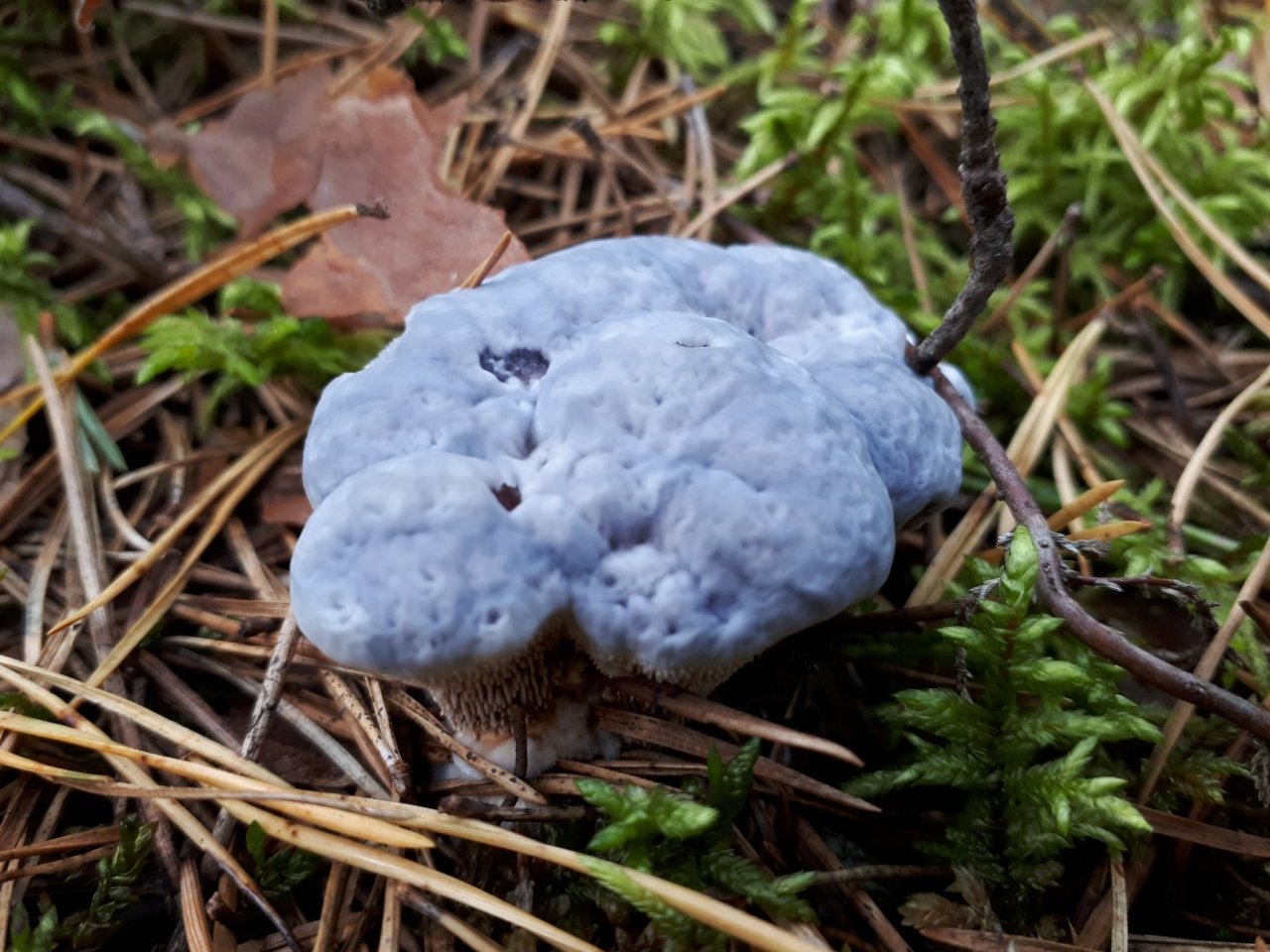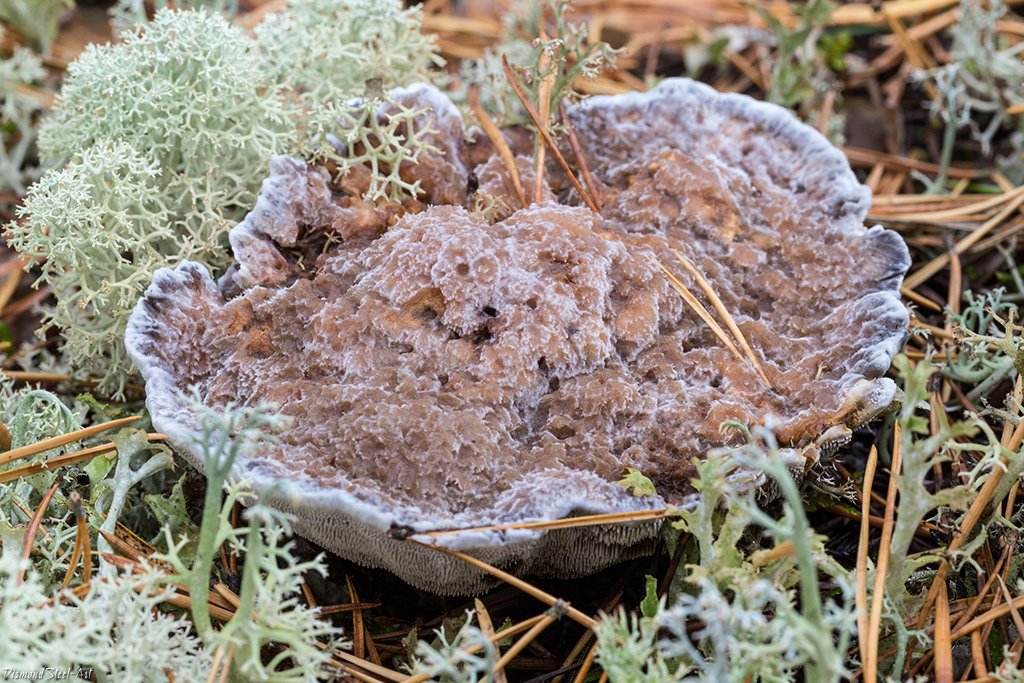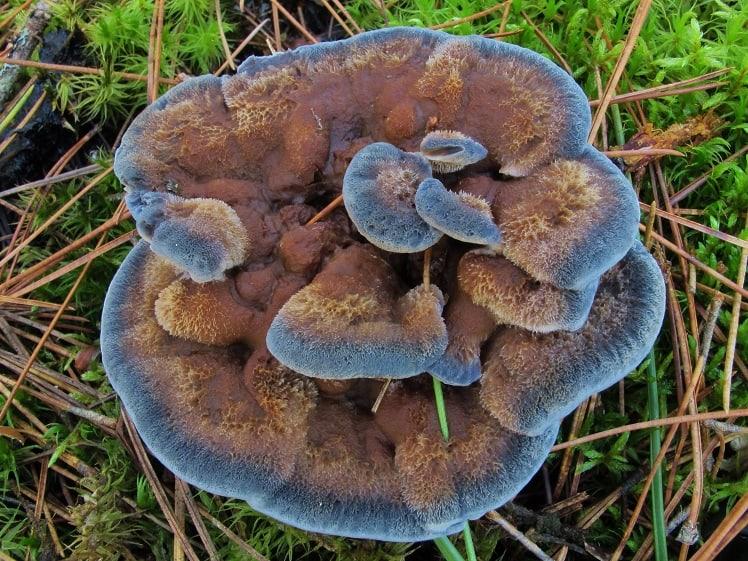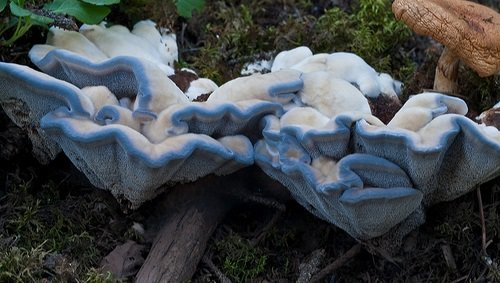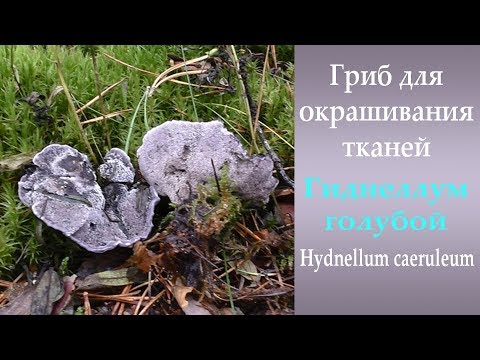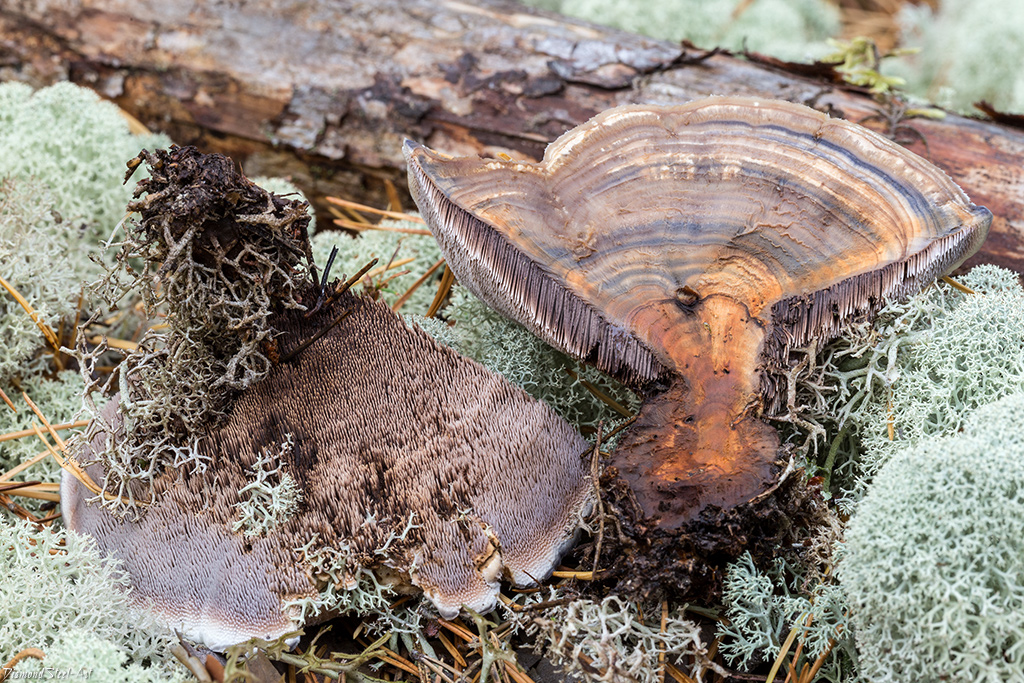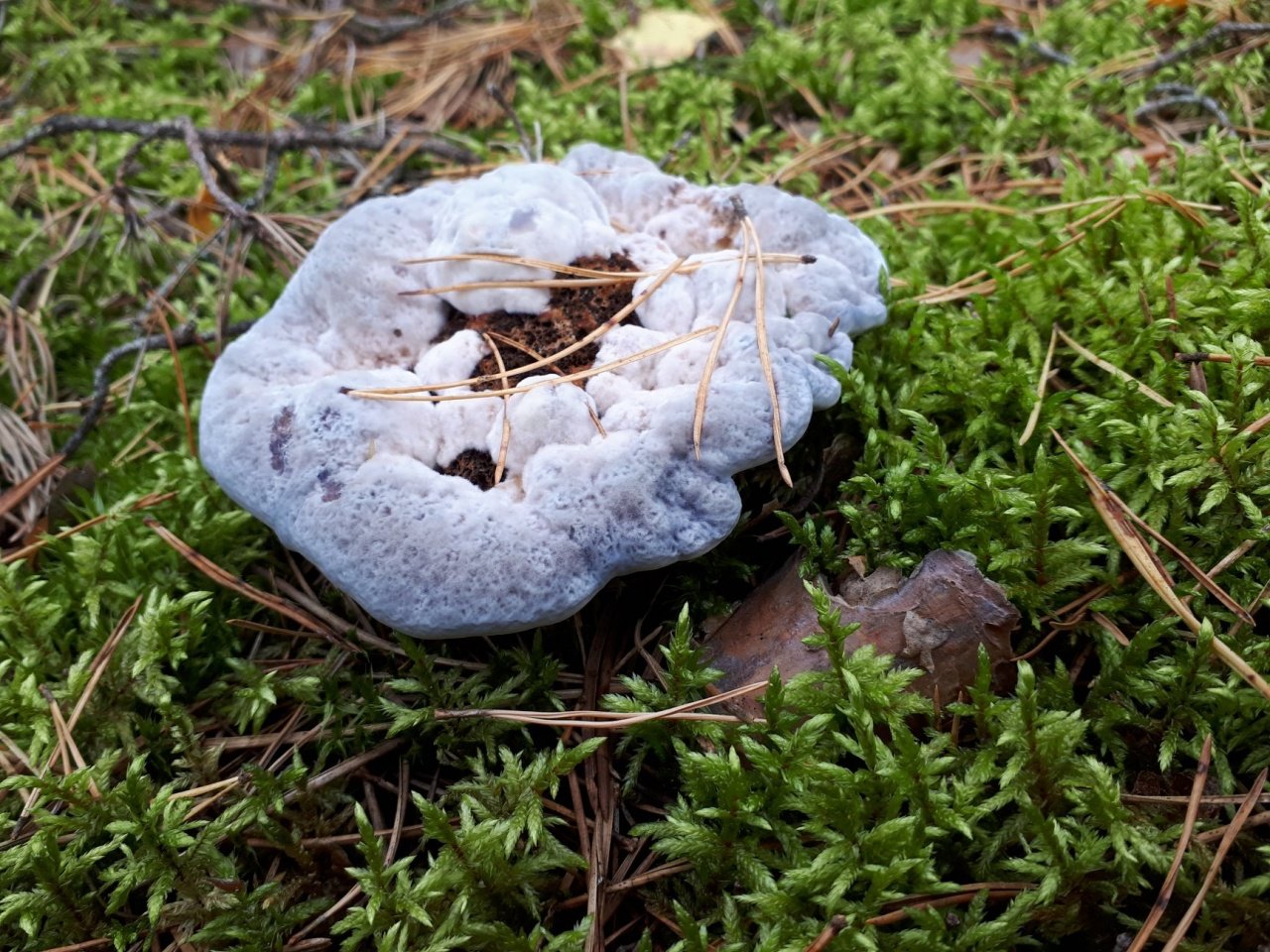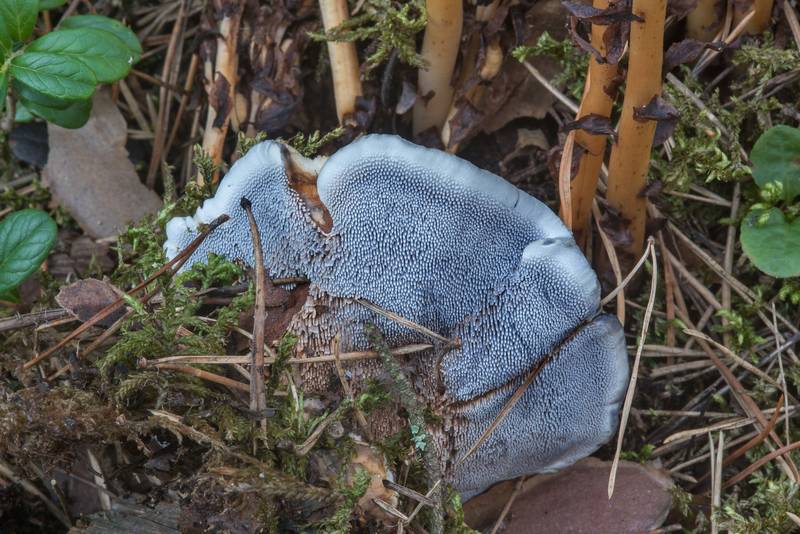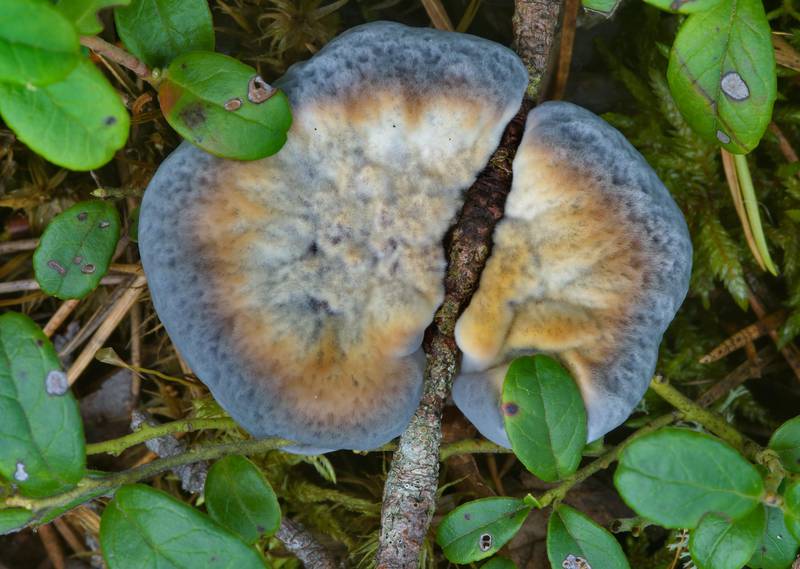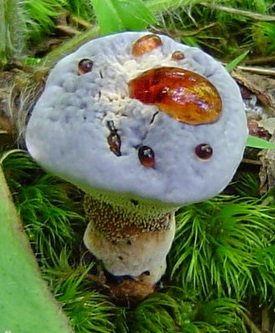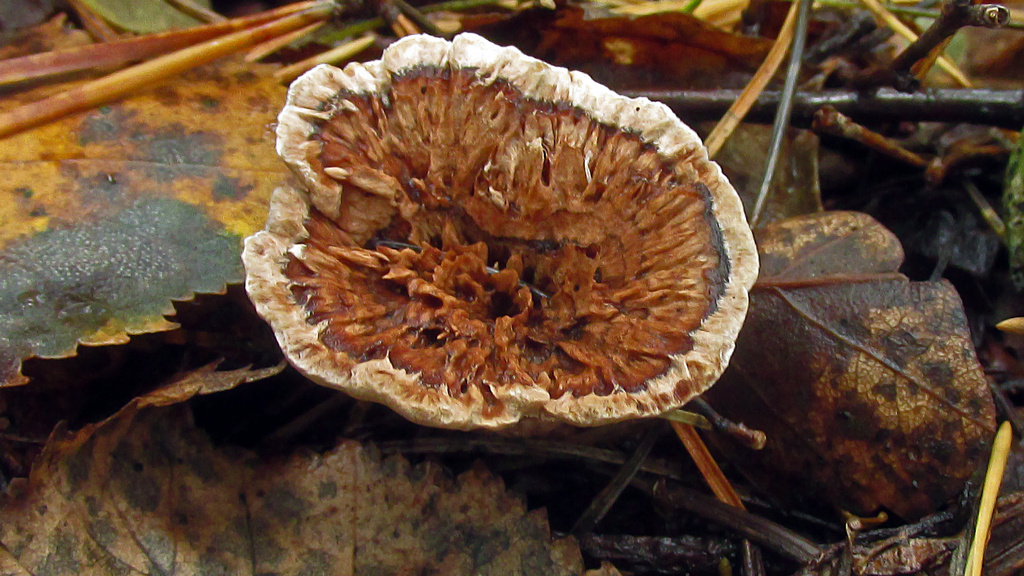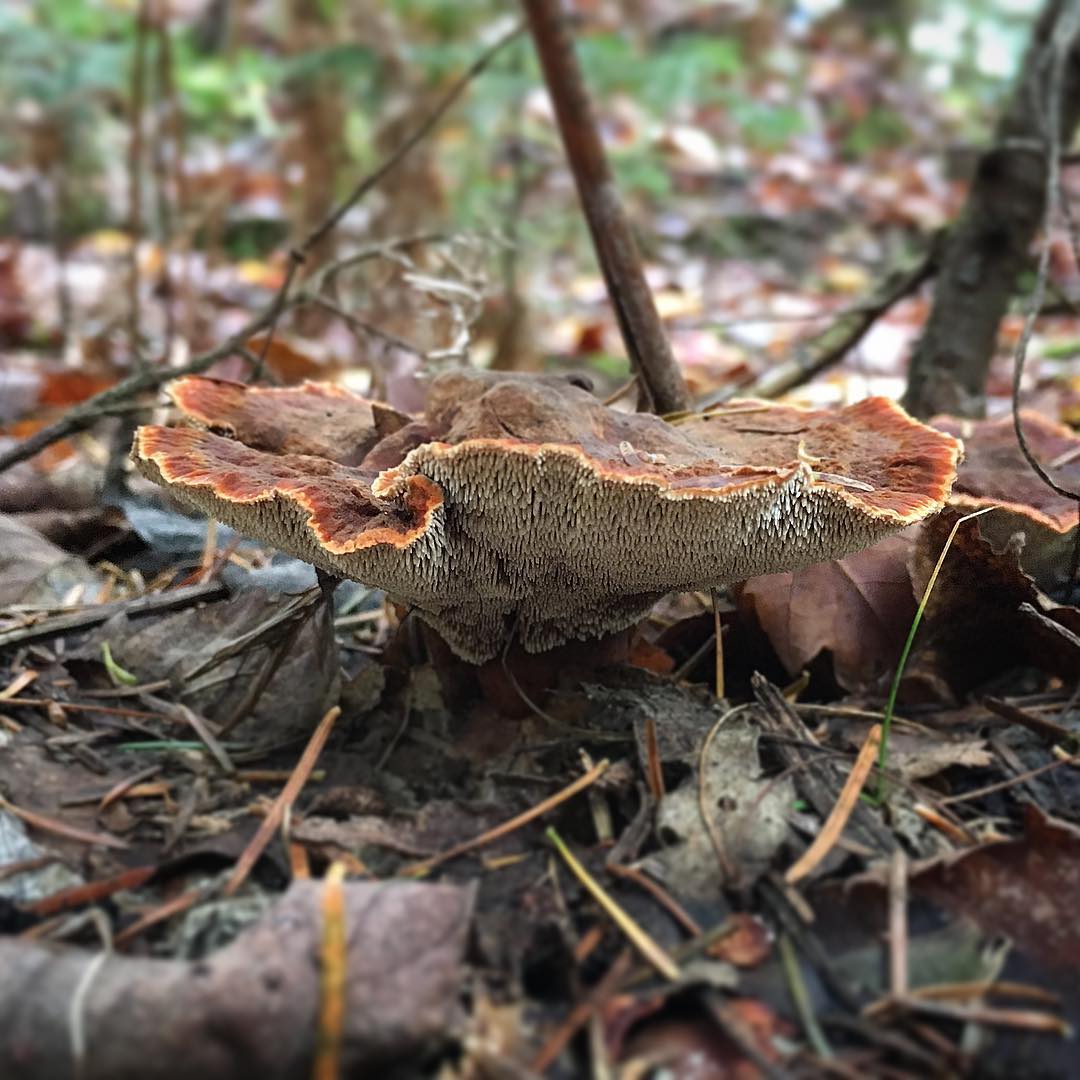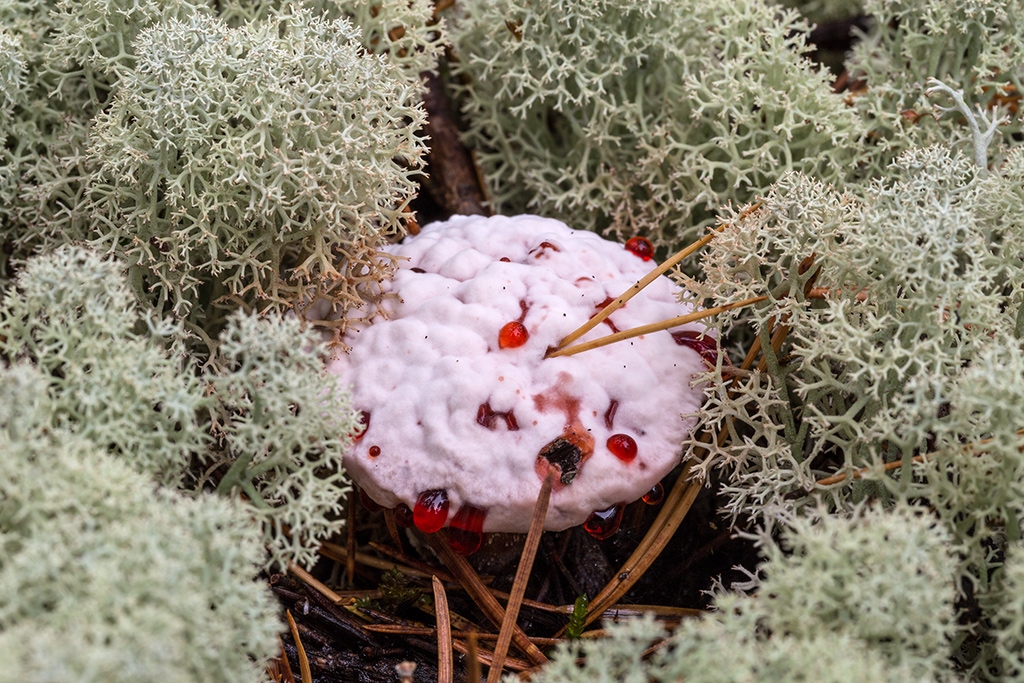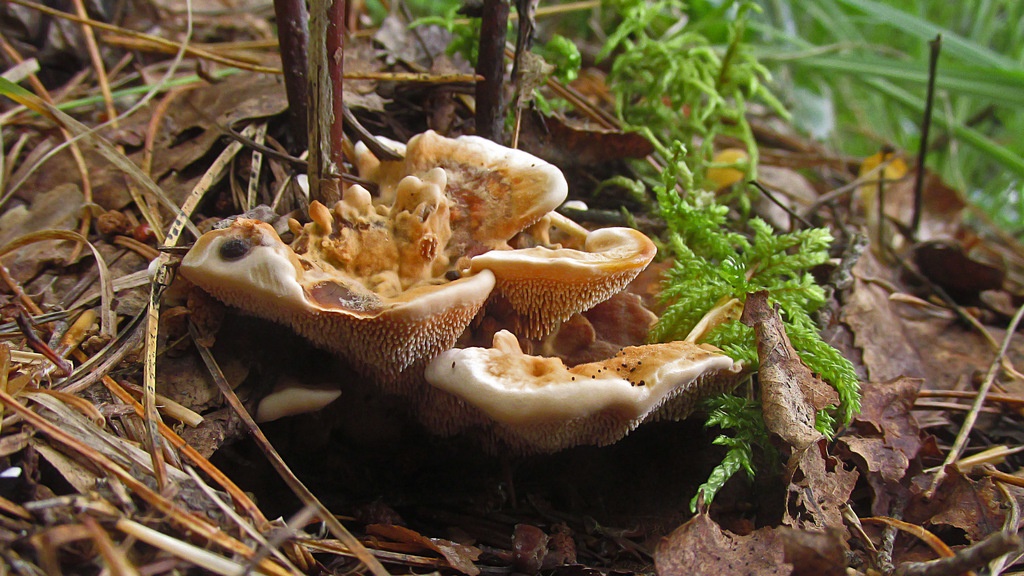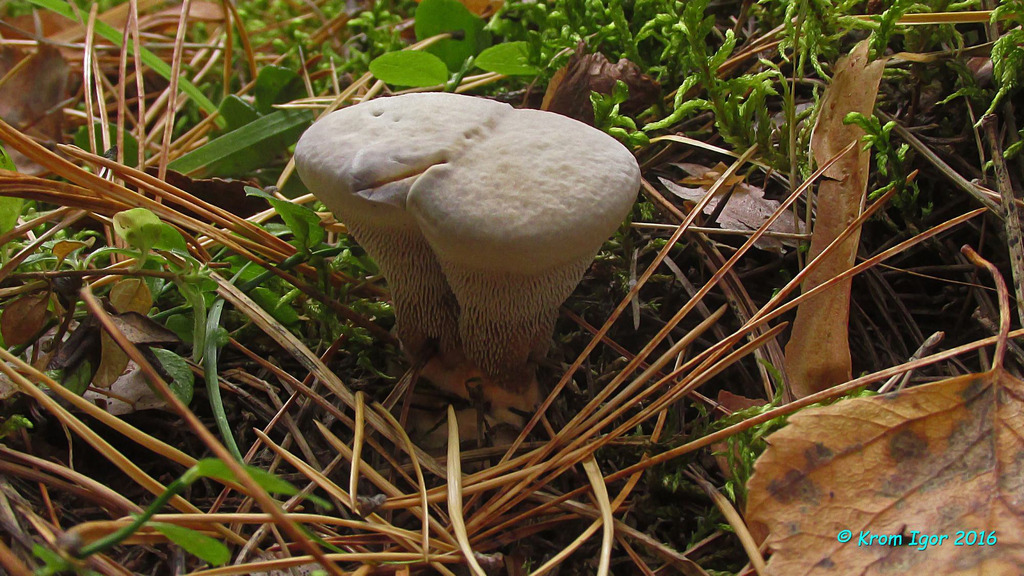External description
The fruiting body of rusty hydnellum is hat-stem.
Hat. The diameter of the cap is 5-10 cm. In young specimens, it has a clavate shape, in mature mushrooms it becomes reverse conical (it is funnel-shaped or flat in some specimens).
The surface is velvety, with many irregularities, often covered with wrinkles, whitish in young mushrooms. Gradually, the surface of the cap becomes rusty brown or pale chocolate. Purple droplets of a protruding liquid are clearly visible on it, which dries up and leaves brown spots on the cap of the fruiting body.
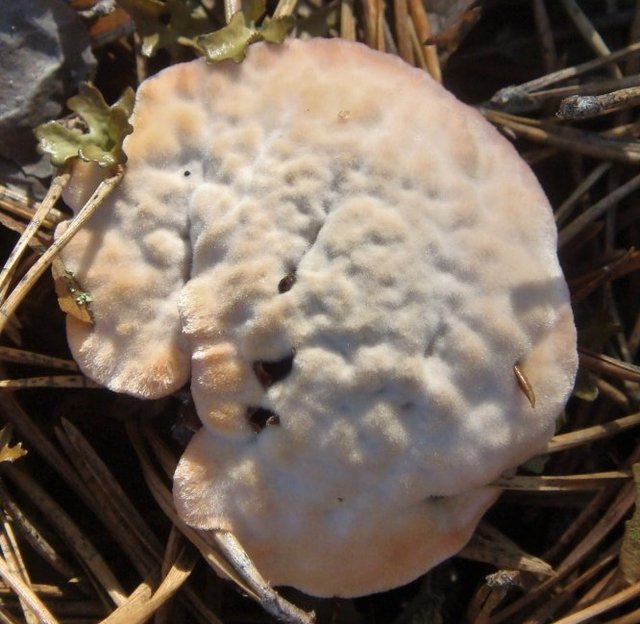
The edges of the cap are even, white, and brown with age. The mushroom pulp is two-layer, near the surface it is felt and loose. It is best developed near the base of the leg, and in this area it has a lighter color. In the center of the cap of rusty hydnellum, the texture of the tissues is leathery, cross-zoned, fibrous, rusty-brown or chocolate shade.
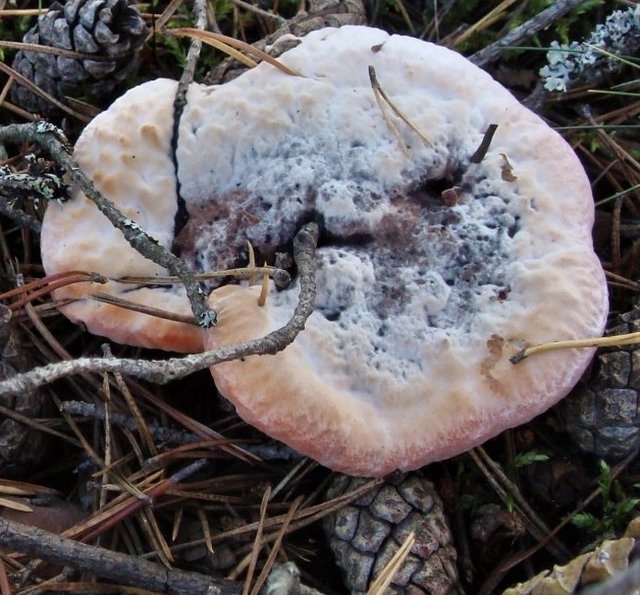
During growth, the fruiting body of the fungus, as it were, "flows around" the obstacles encountered, for example, twigs.
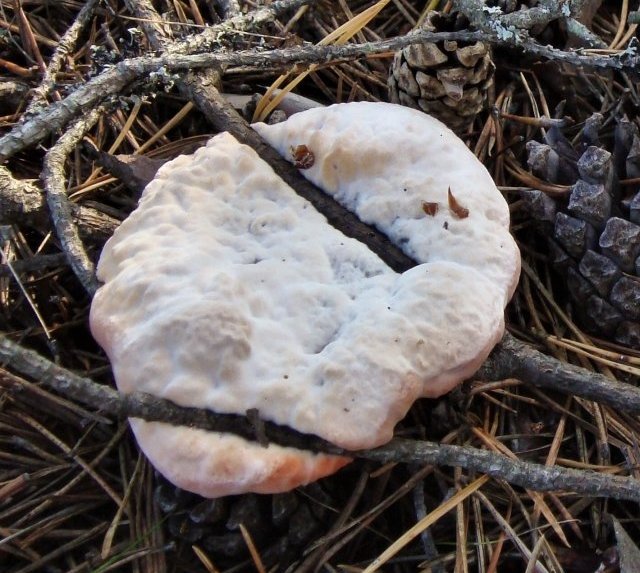
Hymenophore characteristics. Spiny hymenophore, consisting of spines descending slightly down the pedicle. at first they are white, gradually becoming chocolate or brown. They are 3-4 mm long, very brittle.
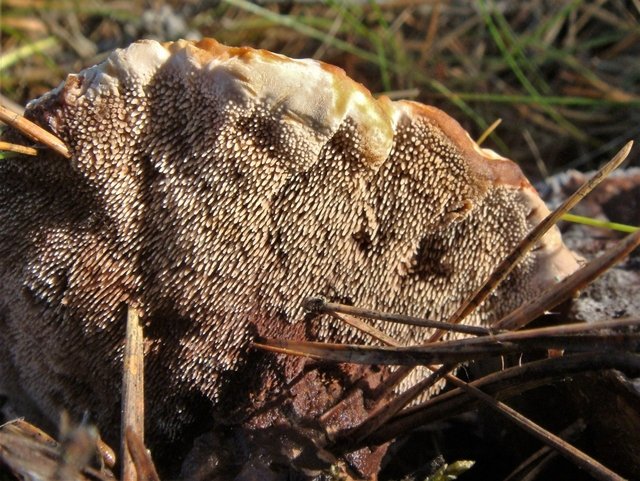
Spines near:

Leg. The height of the rusty gidnellum leg is 5 cm. It itself is completely covered with a rusty-brown soft cloth and has a felt structure.
Microscopic signs. Thin-walled hyphae have slightly thickened walls, do not contain buckles, but there are septa. Their diameter is 3-5 microns, there is a minimum color. Near the surface of the cap one can see a large accumulation of brownish-red hyphae with blunt ends. Rounded warty spores are characterized by a slightly yellowish color and 4.5-6.5 * 4.5-5.5 microns in size.
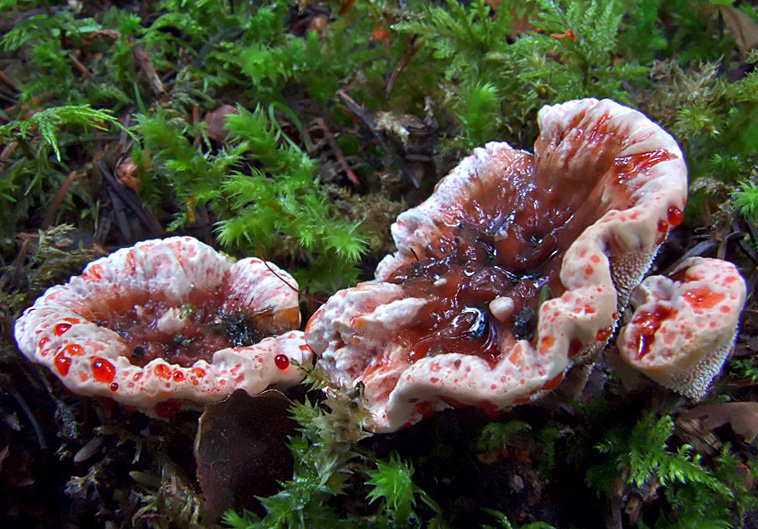
Evaluation of the edibility of gidnellum blue
Gidnellum blue is not used for food, the mushroom is classified as inedible.
Related species of gidnellum blue
Gidnellum odorous is an inedible member of the family. Fruit bodies are lumpy, with a velvety surface. The shape of the fruit bodies is concave. At first, the color of the mushroom is white, but later it becomes dark.

There are bluish spines on the underside. The stem of this mushroom is cone-shaped. Cork pulp, with an unpleasant odor. On the upper surface of young specimens, red drops of liquid can be seen.
The fruiting season for Hidnellum odorous falls in the fall. These mushrooms inhabit mixed and coniferous forests. They choose sandy soil.
Hydnellum Peka is an inedible mushroom, but it looks very appetizing. It looks like a raspberry syrup cake. The surface of the fruit bodies is velvety. The color is beige, over time it can turn brown. Its pulp is of a corky consistency with an unpleasant taste.
Pek's hydellums grow in the forests of Europe, Australia and North America. These mushrooms feed not only on substances from the soil, but also on insect juices, which land on the mushroom, attracted by bright drops of "syrup". Hydnellum Peka has high antibacterial properties. It contains elements that promote blood thinning.

Season and habitat of the mushroom
Hydnellum dark brown (Hydnellum ferrugineum) grows mainly in pine forests, prefers to develop on depleted sandy soil and is picky about its composition. Widely distributed in coniferous forests, with spruce, fir, pine. Sometimes it can grow in mixed or deciduous forests. The fungus of this species has the property of reducing the concentration of nitrogen and organic matter in the soil.
Rusty hydnellum thrives in old lingonberry forests with white moss, in the middle of old dumps along forest roads.Grows on soils and substrates. These mushrooms often surround the bumps and pits formed by heavy machinery. You can also see rusty hydellums next to forest paths. The fungus is ubiquitous in western Siberia. Fruiting from July to October.
Spreading
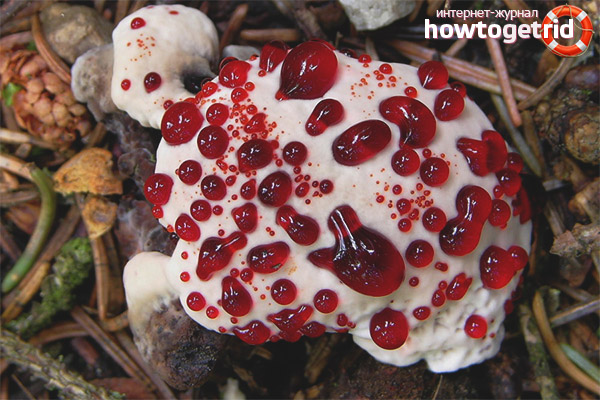
- An amazing fact remains that the fruit bodies in question can be found exclusively in coniferous strips. The most favorable conditions for such a mushroom are North America, central Europe and Australia.
- In addition, the specimens presented can be found in Korea, the Pacific Northwest and Iran. Only in rare cases can such fruits be found in the CIS countries. However, do not forget that the climate on our planet is constantly changing. Therefore, new types of mushrooms appear where they have never been seen before.
- It is also worth noting that in the usual places of distribution, some types of fruit bodies, on the contrary, disappear without a trace. As for the specimens in question, they prefer to grow in sandy soil.
- The fact is that it is easiest to absorb moisture from it. Such mushrooms prefer loneliness, so if you meet such a specimen on your way, there will definitely be one. Small groups are found only in rare cases.
Evaluation of the edibility of hydnellum odorous
These mushrooms have no culinary value, they are inedible.
The medicinal properties of odorant hydnellum
These are antioxidant mushrooms. In 2006, studies were carried out and the antioxidant activity of odorant hydnellum was revealed. These mushrooms contain substances that have the same activity as α-tocopherol.
Related species
Hydnellum Peka is an inedible type of mushroom. It is also called the devil's hedgehog and the bleeding tooth. It looks delicious, like chewing gum with drops of raspberry syrup. This fluid forms inside the fruiting body and oozes out of the pores. Fruit body surface white in color, later it can turn beige or brown. The diameter of the mushroom is 5-10 centimeters.
Hydnellum Peka can be found in coniferous forests. They grow in North America and Europe. These mushrooms have antibacterial properties. This is a special mushroom - it can feed not only on juices from the soil, but also on insects that fall on the surface of the fruit body.
Gidnellum blue is an inedible mushroom. The hat is large - its diameter can reach 20 centimeters, and its height reaches 12 centimeters. Above the hat is light blue, and the lower part is darker. The cap has small spines, the length of which is about 4 millimeters. The surface of the mushroom is uneven and bumpy, slightly velvety. The leg is short, half immersed in the moss. The color of the leg is brown. The pulp is without a special smell, tough in consistency.
Gidnellum blue prefers to grow in pine forests located in the northern part of the European hemisphere. They like to settle in sunny places with white moss. Almost always, these mushrooms grow singly, only sometimes they gather in small groups. Fruiting is observed from July to September.
Description
- Some inexperienced lovers of quiet hunting are seriously scared when they first see this mushroom. But at the same time, they admire the external characteristics of the fruiting body. It is interesting that not only people are attracted by the color of the specimen, but also by insects, which subsequently act as an excellent meal. The mushroom is white in color, velvety in structure, but turns brown over time.
- This variety does not have the function of absorbing carbon dioxide. Therefore, they prefer to eat valuable substances obtained from the earth, as well as insects. They stick to the surface of the fruiting body, then die.
- Let's go directly to the description of the mushroom itself. It is whitish with a slight pink tint. The hat is velvety, has an interesting format with armholes and folds.On the depressions, some dots are seen, similar to drops of a red hue. The liquid comes out through the pores. In some categories of persons, these drops are associated with bloody footprints. With the passage of age, a kind of growths similar to teeth are formed at the edges of the fungus. It is due to this feature that the mushroom was nicknamed the bleeding tooth.
- The top is colored with a faded pink tint, the shape of the hat is irregular, it grows up to 7-10 cm. When the mushroom grows old, its hat changes. It becomes not fleshy and white, but takes on a black and red color.
- This variety of fruiting bodies has a short base, the leg hardly grows up to 2 cm in height. It hides in the soil, so it is often invisible. The stem is conical, white, matching the shade of the apex. The soft part is also light, whitish, closer to the leg it becomes dark. Reproduction is carried out by spores of a brown tone, in the lower part of the specimen there are mushrooms with these spores.
- Now separately about the smell and taste. The aroma is almost absent, but some people think that the mushroom gives off juicy strawberries. It tastes bitter, it cannot be tasted, the specimen is dangerous to humans. Its toxicity has not been studied, so it is not worth trying. It can be said unambiguously that the mushroom is not consumed as food. As for the growth, you can find the family from the beginning to the end of autumn.
Interesting facts about Bloody Tooth
Some Fun Facts About The Devil's Mane:
- In addition to the fact that this mushroom is very bright and beautiful, it is one of the interesting species from the point of view of biology. The connection of gidnellum with the environment of the forest, where it grows, is very dense. Scientists have found that mycelium binds to tree roots.
- Pitch is the most dangerous representative of the flora. Although the pulp does not pose any danger, a few drops of juice can kill a completely healthy person in a matter of minutes.
- The bloody mushroom often becomes the inspiration in the art world. Due to its truly deadly beauty, it is often seen at photo exhibitions.
- The mushroom juice is able to be absorbed into the skin, after which it cannot be completely removed from the body. After a quiet hunt, many mushroom pickers noticeably worsened their well-being, so experts strongly discourage even touching it.
- Gidnellum is spreading around the world in an unknown pattern. If a hundred years ago it could be found only in North America, then already in the 21st century it was seen in Iran and China.
- According to the research results, it was revealed that the mycelium can spread within a radius of 3 meters. This is a very high indicator among mushrooms, since the average spreading distance is no more than 1 meter.
Today, in order to find the devil's hedgehog, scientists use modern technologies that, by cultivating the soil, can find the DNA of the fungus. Since even if the bodies themselves cannot be visually detected, this does not mean that they are not at all. Mycelium can be stored in soil for years.
Mushroom Bloody Tooth
A mysterious and unique representative of the mushroom kingdom is the Bloody Tooth mushroom, which got its name from its unusual appearance. It was first written about it in 1913, although it was discovered much earlier, back in 1812. Interestingly, scientists have not yet fully studied its properties.
Appearance (description)
Some representatives of nature on our planet surprise and horrify. These include the extraordinary mushroom "bloody tooth". It is found in coniferous forests in the European and North American territory.
It's hard not to pay attention to this mushroom, because its bright color immediately attracts the eye.
The name "Gidnellum Peck" was given after the name of the mycologist from the USA Peck, who first discovered this species. The size of the mushroom is average, the cap is slightly more than 5 cm in diameter, similar to chewed gum with a delicate strawberry smell, the leg is about 2 cm high. On the surface of the cap, bright blood drops appear, as if it is stained with the blood of a wounded animal.This red liquid is produced by the fungus itself through the pores. "Hydnellum peckii" is somewhat similar to boletus with wedge or currant juice spilled on it. The body is white, velvety, turns brown with aging.
The main characteristic of the "bloody tooth" is the absorption of water from the soil and feeding on small insects that accidentally fall into it. The word "tooth" appeared in the title for a reason. When "Hydnelum Peka" grows, pointed formations appear along its edges.
Edible or not?
"Gidnellum Peka" refers to the order of Agaricales, however, unlike the same champignons, it is not edible. The fruit body does not contain poison, the danger comes only from the pigment in the cap (atromentin). Its toxicity is still being studied and it is not yet known whether it is fatal to humans. The mushroom tastes bitter - it needs it to scare away people and animals.
Where and when does the Bloody Tooth mushroom grow?
As we said above, this mushroom grows in the coniferous forests of Australia, Europe and North America. In the Russian Federation, you can see it extremely rarely and only in the autumn season from September to November. Not so long ago, it was discovered in Iran, North Korea and the Komi Republic.
Mr. Summer resident: the healing properties of a bloody tooth
In the course of the study, scientists found that the mushroom juice contains a substance atromentin, which is a specific anticoagulant. It can be used to prevent blood clots and improve blood clotting. It is also believed that the use of a tincture of alcohol and a bright poisonous liquid of the mushroom helps heal bruises, since the latter has pronounced antibacterial properties.
Some doctors hope that in the near future a drug will be created on the basis of the purple substance, akin to penicillin, which was obtained from the mushroom of the same name.
Similarities with other species
The mushroom has close relatives:
- Rusty Hydnellum (Hydnellum ferrugineum). It can be easily distinguished from a "bloody tooth" with aging, initially a white body with liquid red drops in shade begins to resemble rust.
- Blue Hydnellum (Hydnellum caeruleum). Grows near white mosses in the forests of Northern Europe. On its pulp, the same bloody drops stand out, and it is distinguished by its distinct blue color. With aging, the center of the cap turns brown.
- Odorous Hydnellum (Hydnellum suaveolens). The light fruiting body with blue thorns darkens with aging, has a pungent odor. No red liquid is released.
Description of gidnellum blue
Gidnellum blue has an impressive size - its cap in diameter can grow up to 20 centimeters. And the height of the fruiting body is about 12 centimeters. The surface of the fungus is uneven and bumpy, and at a young age it can be slightly velvety.

Above, the surface of the cap is light blue, and its lower part is darker. The hat is irregular. It is dotted with small spines up to 4 millimeters long. At a young age, the thorns are blue or purple in color, but later they darken or may turn brown. The leg is short, completely submerged in the moss. The color of the leg is brown.
The pulp is stiff, dense, without a definite odor. A special liquid forms inside the mushroom, which can protrude through the spores, which makes it seem that the mushroom is dripped with red syrup.

Growing places of blue hydnellum
The mushroom prefers pine forests growing in the north of the European hemisphere. Hydnellum blue can be found in sunny locations. These mushrooms grow among white moss. Almost always there are single specimens, only sometimes small groups are formed from fruiting bodies. Fruiting time falls in July-September.

